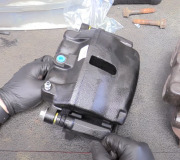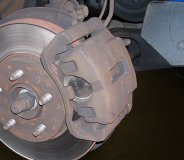First of all, reach behind one of the wheels that is sticking and open the bleeder screw. If the caliper releases, you know it is ok.
If the brake pedal seems higher and harder to push than normal, suspect rust buildup inside the crimp around the metal bracket that holds the center of the rubber brake hose. The rust pinches off the hose so that caliper is hard to apply and will not want to release. You can peel the bracket open slightly with a channel lock pliers. I've only seen this twice in 25 years working on cars; once on my minivan that had been sitting for months and once on a student's Neon. They were two weeks apart!
More likely, since the second brake acted up the same way a short time later, I'm leaning toward contaminated brake fluid. Look at the rubber bladders under the caps of the master cylinder reservoir. If they are ballooned up, the fluid is contaminated with a petroleum product. That will cause rubber parts to swell and get mushy. The only proper repair is to replace every single part that has rubber in it and to flush and dry all the steel lines. As the seals grow, they block off the fluid return ports in the master cylinder. That's the same as driving with your foot on the brake pedal. The trapped fluid keeps the brakes applied so they get hot. That causes the fluid to expand which applies the brakes even harder, and they get hotter.
This is a split-diagonal system so the front brakes are on different hydraulic circuits. Left front and right rear are on one system. Fluid contamination will almost always affect the two front wheels at different times as it takes longer for the contaminant to reach the second set of seals.
Any rubber parts not replaced will hold in contamination that will be released again into the system over time. That's why it is absolutely necessary to replace everything that has rubber seals or o-rings. Four hoses, master cylinder, calipers, wheel cylinders, height-sensing proportioning valve by the left rear wheel, combination valve on the frame rail under the master cylinder if you don't have anti-lock brakes, hydraulic control unit if you do have ABS. I'd recommend finding a good used reservoir from the salvage yard since they don't usually come with a new master cylinder.
Fluid contamination is a very costly repair. Let's hope it's just the two metal brackets on the front hoses. One pinched off hose is not unusual. Two would be quite the lucky coincidence.
Caradiodoc
Saturday, December 12th, 2009 AT 11:27 AM



